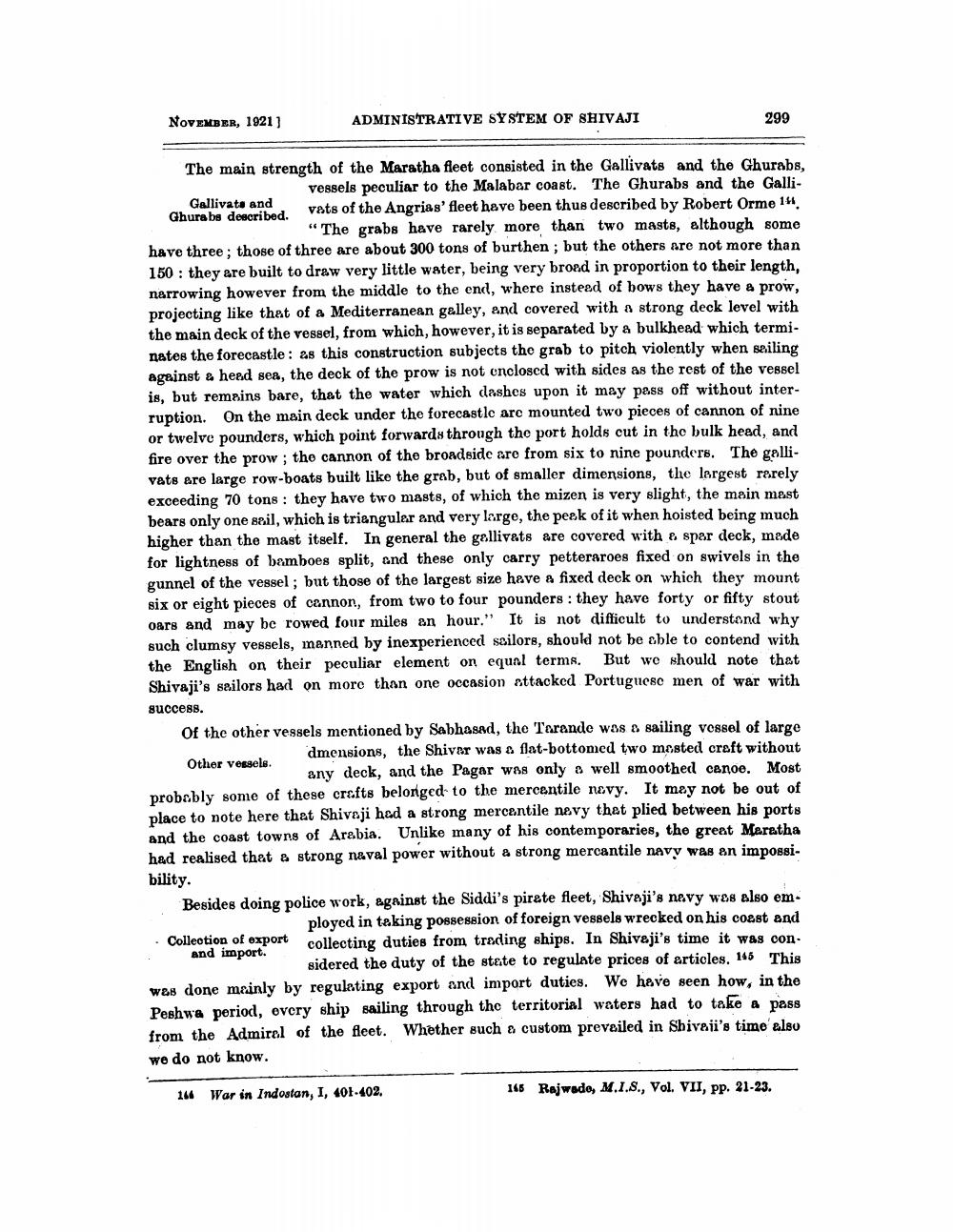________________
NOVEMBER, 1921)
ADMINISTRATIVE SYSTEM OF SHIVAJI
299
The main strength of the Maratha fleet consisted in the Gallivats and the Ghurabs,
vessels peculiar to the Malabar coast. The Ghurabs and the GalliGallivata and Ghuraba described.
vats of the Angrias' fleet have been thus described by Robert Orme 14.
“The grabs have rarely more than two masts, although some have three; those of three are about 300 tons of burthen ; but the others are not more than 150 : they are built to draw very little water, being very broad in proportion to their length, narrowing however from the middle to the end, where instead of bows they have a prow, projecting like that of a Mediterranean galley, and covered with a strong deck level with the main deck of the vessel, from which, however, it is separated by a bulkhead which terminates the forecastle: as this construction subjects the grab to pitch violently when seiling against & head sea, the deck of the prow is not enclosed with sides as the rest of the vessel is, but remains bare, that the water which dashes upon it may pass off without interruption. On the main deck under the forecastle are mounted two pieces of cannon of nine or twelve pounders, which point forwards through the port holds cut in the bulk head, and fire over the prow; the cannon of the broadside are from six to nine pounders. The gallivats are large row-boats built like the grab, but of smaller dimensions, the largest rarely exceeding 70 tons: they have two masts, of which the mizen is very slight, the main mest bears only one sail, which is triangular and very large, the peak of it when hoisted being much higher than the mast itself. In general the gallivets are covered with a spar deck, made for lightness of bamboes split, and these only carry petteraroes fixed on swivels in the gunnel of the vessel ; but those of the largest size have a fixed deck on which they mount six or eight pieces of cannon, from two to four pounders: they have forty or fifty stout Oars and may be rowed four miles an hour." It is not difficult to understand why such clumsy vessels, manned by inexperienced sailors, should not be able to contend with the English on their peculiar element on equal terms. But we should note that Shivaji's sailors had on more than one occasion attacked Portuguese men of war with guccess. Of the other vessels mentioned by Sabhasad, the Tarande was & sailing vossel of large
dmensions, the Shiver was a flat-bottomed two mosted craft without Other vessels.
any deck, and the Pagar was only well smoothed canoe. Most probably some of these crafts belonged to the mercentile nevy. It may not be out of place to note here that Shivaji had a strong mercantile nevy thet plied between his ports and the coast towns of Arabia. Unlike many of his contemporaries, the great Maratha had realised that & strong naval power without a strong mercantile navy was an impossibility. Besides doing police work, against the Siddi's pirete fleet, Shivaji's nevy was also em
ployed in taking possession of foreign vessels wrecked on his coast and • Collection of export collecting duties from trading ships. In Shivaji's time it was conand import.
sidered the duty of the state to regulate prices of articles. 146 This was done mainly by regulating export and import duties. We have seen how, in the Peshwa period, every ship sailing through the territorial waters had to take a pass from the Admiral of the fleet. Whether such a custom preveiled in Shivaji's time' also we do not know.
144
War in Indostan, I, 401-402.
146 Rajwado, M.I.S., Vol. VII, pp. 21-23.




